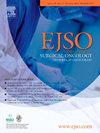手术切缘是否真的影响乳腺良性和交界性叶状瘤的局部复发?
IF 2.9
2区 医学
Q2 ONCOLOGY
引用次数: 0
摘要
背景:乳腺叶状瘤很少见,根据其恶性潜能可分为良性、交界性和恶性三大类。手术切除是主要的治疗方式;然而,明确手术切缘的必要性在文献中仍然是一个有争议的话题。本研究旨在评估良性和交界性叶状瘤的手术切缘状态与局部复发的关系。方法选取两个中心诊断为叶状瘤的177例患者。根据人口统计学、临床、病理和生存数据对患者进行分析。结果中位年龄38岁(15 ~ 78岁),均为女性。173例(97.7%)患者最常见的乳房手术是广泛的局部切除。最终病理检查显示良性叶状瘤136例(76.8%),交界性叶状瘤41例(23.2%)。病理肿瘤中位直径35 mm (IQR: 27 ~ 55 mm)。在中位随访60个月期间,12名患者(6.8%)出现局部复发,未观察到全身转移或肿瘤相关死亡。交界性叶状瘤患者的局部复发率较高,无复发生存期(RFS)较短(p = 0.022, p = 0.013)。Cox回归分析发现肿瘤类型是影响RFS的唯一独立因素,交界性叶状瘤的RFS较良性叶状瘤短(p = 0.015)。结论手术切缘状态与良性和交界性叶状瘤的局部复发无关。因此,基于边缘接近或阳性的再切除决定应个体化。本文章由计算机程序翻译,如有差异,请以英文原文为准。
Does surgical margin status truly affect local recurrence in benign and borderline phyllodes tumors of the breast?
Background
Phyllodes tumors of the breast are rare and classified into three groups—benign, borderline, and malignant—based on their malignant potential. Surgical resection is the primary treatment modality; however, the necessity of clear surgical margins remains a topic of debate in the literature. This study aimed to evaluate the relationship between surgical margin status and local recurrence in benign and borderline phyllodes tumors.
Methods
A total of 177 patients diagnosed with phyllodes tumors from two centers were included. Patients were analyzed based on demographic, clinical, pathological, and survival data.
Results
The median age was 38 years (range: 15–78), and all patients were female. The most commonly performed breast surgery was wide local excision in 173 patients (97.7 %). Final pathological examination revealed that 136 patients (76.8 %) had benign phyllodes tumors, while 41 patients (23.2 %) had borderline phyllodes tumors. The median pathological tumor diameter was 35 mm (IQR: 27–55 mm). During a median follow-up of 60 months, local recurrence occurred in 12 patients (6.8 %), while no systemic metastasis or tumor-related death was observed. Patients with borderline phyllodes tumors had a higher local recurrence rate and shorter recurrence-free survival (RFS) (p = 0.022 and p = 0.013, respectively). Cox regression analysis identified tumor type as the only independent factor affecting RFS, with borderline phyllodes tumors demonstrating a shorter RFS compared to benign phyllodes tumors (p = 0.015).
Conclusion
Surgical margin status was not associated with local recurrence in benign and borderline phyllodes tumors. Therefore, re-excision decisions based on margin proximity or positivity should be individualized.
求助全文
通过发布文献求助,成功后即可免费获取论文全文。
去求助
来源期刊

Ejso
医学-外科
CiteScore
6.40
自引率
2.60%
发文量
1148
审稿时长
41 days
期刊介绍:
JSO - European Journal of Surgical Oncology ("the Journal of Cancer Surgery") is the Official Journal of the European Society of Surgical Oncology and BASO ~ the Association for Cancer Surgery.
The EJSO aims to advance surgical oncology research and practice through the publication of original research articles, review articles, editorials, debates and correspondence.
 求助内容:
求助内容: 应助结果提醒方式:
应助结果提醒方式:


